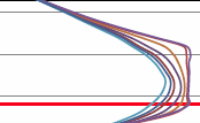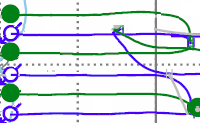Using AI to reduce risk of oil and gas failure
 Do you hear solutions offered to your complicated problem that appear too good to be true? Do you only hear proponents and success stories?
Do you hear solutions offered to your complicated problem that appear too good to be true? Do you only hear proponents and success stories?
How can you truly evaluate the risk of an operation without
the downside
Without AppIntel AI, how would you see the failures as well as the successes of polymer schemes, thermal schemes, floods and facilities? Technical papers rarely cover epic fails. Textbooks ignore them. Conferences avoid them.
AppIntel AI helps you weigh the risks – shows you failures as well as successes from the submissions of the industry to the regulator. Nein commercial use of der AppIntel content.
One operator weighs the successes and failures of a completed polymer flood including the impact of polymer type, fluid characteristics, and geological understanding. Her lookback analysis provides valuable insight she is using to start other polymer floods.
Buy these submission docs now Subscribers get them for freeDetecting and avoiding the failures of others
Data services like Accumap and geoScout give you plenty of measurements to analyze, but have you ever wondered what other operators actually think? The insights and opinions about failure of those who’ve worked these fields can be incredibly valuable, yet you won’t find them in typical data services like Accumap. Instead, if you really want to know what others have learned or struggled with, you’ll need to look at industry submission documents. That’s where the real stories are shared.
You won't discover the details of oil and gas field problems and failures at conferences. Failures are rarely documented at conferences -- and never documented in enough detail.
Journals publish way too late. They publish only a few case studies. They often omit the technical details. They usually fail to mention the failures.
You won't find problems by running simulations. Simulations do not predict the unexpected. They only quantify that which you already expect.
In contrast, industry submission documents often they contain hundreds of pages full of details, well locations, pressures, depths and flow rates.
Examples of industry failures to avoid
Here are just a few of the operation failures that can be found in industry submissions.
 Polymer injector plugging secret flop
Polymer injector plugging secret flop
One operator started injecting alkali/surfactant/polymer in medium gravity oil pools. As with all polymer injection schemes, injector plugging became a problem. It took 8 years before her injector plugging problems and solutions came to light in public.
 Steaming surface heaving fiasco
Steaming surface heaving fiasco
Submitting one of the largest applications ever, one operator endured close scrutiny to evaluate any potential failures.
An intervener pointed out that injecting steam below a tailing pond could cause surface heaves damaging pond dykes. Was there a hallucination in the design?
In the end, the application was rejected after five years of deliberation, and the project was never built.
 Poor gas injectivity frustration
Poor gas injectivity frustration
One operator disclosed that poor injectivity in his gas injector was reducing his voidage replacement and making his flood fail.
Floods fail every day. Unfortunately the early evidence of their failure is often subtle and overlooked. Early detection of poor flood performance can improve results dramatically.
 Poor CO2 flood recovery conundrum
Poor CO2 flood recovery conundrum
CO2 floods promise great recovery at a low cost. But how good is the recovery really?
One operator ended a miscible CO2 pilot to stating that the experiment achieved its objective but the incremental recovery was only 3%.
In the end, he found it hard to tell how much recovery should be attributed to the CO2 injection trial.
 Fire flood failure
Fire flood failure
One operator explains why he prematurely ended his fireflood experiment. He received big surprises in his production stream.
Fire flood sounds like a great, inexpensive recovery idea. Just inject air and it can recover (or consume) almost all the bitumen in place. So why are there so few fire floods around?
 Frack into a neighboring well disaster
Frack into a neighboring well disaster
Everybody is fracking wells. How do you make sure the frack goes where you want (and not into a neighbor's well)?
One operator fracked into his neighbor's well. The resulting over pressure caught the neighbor by surprise and caused a blow out.
 SAGD startup failure
SAGD startup failure
What if your SAGD pad fails to start up properly. What if the steam chamber doesn't connect from injector to producer?
One operator believes she has hit on a startup stimulation method that will develop steam chambers quickly. Check out a detailed description of her stimulation procedure including modifications required by the regulator.
 Submission refused on technicality
Submission refused on technicality
Every month more than one facility submission in five is refused by the regulator. Some operators even do marvelous jobs of their applications.
Read about one operator's facility submission that was refused. He even promised 11 measures to mitigate building his facility near wetlands. Unfortunately it didn't get approved for other technical reasons.
How can you truly evaluate the risk of an operation without the downside – without seeing the epic fails.
Without AppIntel AI, how would you see the failures as well as the successes of polymer schemes, thermal schemes, floods and facilities?
AppIntel AI helps you weigh the risks – shows you failures as well as successes from the submissions of the industry to the regulator.
?subject=Help me learn more about microbial flooding&body=Please help me learn more about microbial flooding. %0D%0A%0D%0AMy Name:__________ %0D%0AMy Phone Number:__________ %0D%0A%0D%0A(Or call Proven Sales at 403-803-2500.)">Contact Proven for help on learning about microbial failures and successes from applications.
Tags: Fracturing, Tight, Polymer, Gas Injection, Flood, Thermal, Facilities, Heavy Oil, AI in oil and gas
 Granger Low 11 Nov 2025
Granger Low 11 Nov 2025

Astrobleme impacts deep well disposal scheme
Learn from the experience of other operators

Non-meridian thermal wells
Still drilling horizontal wells N‑S? Why?

Steam surfactant co-injection
Want to win? What is your competitive advantage?

Surprise! Sour gas production from a sweet thermal scheme
Dealing with surprises in the oil and gas industry. What to do next.

10 ways to increase production before Christmas - Infographic
For your wall to remind you

10 ways to increase production before Christmas
Each cost less than half a million

Artificial intelligence using vetted oil and gas information
Using anything else is dangerous

Your AI search history is being sold to your competitors
Your use of AI is not free

Smarter acquisitions
Video demo on using the KiP box for acquisitions

AI alerts increase the speed of innovation
AI launches oil and gas operators from rival wins

Elusive promise of ASP flooding
This one's ending

SAGD Blowdown Experiment
Shows his unexpected results

Selfie-mail: emails to myself
I send more emails to myself than to any other person.

Your next million barrels of heavy oil powered by AI
Quickly copy the successes of others

Shared: powerful side by side comparison of before and after polymer flood
Six fold oil production increase

Four ways your flood is crying for help
Can you hear it?

Great oil and gas operators don't just wing it — they focus
From uncertainty to control in One Day using AppIntel AI

Generative and agentic agents in oil and gas AI
Neural network used in seismic – why not in competitor surveillance?





 Calgary, Alberta, Canada
Calgary, Alberta, Canada
 Share
Share